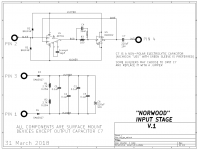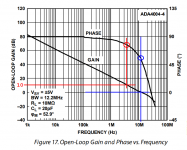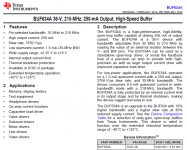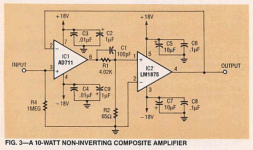Just think, I had almost forgotten you. Very telling you said that, I have never published a single word on power amps. Bob and Doug might be pleased though.
Got Bybees?
hahaha. Just having fun with you. Of the 3, you seem to be here more than the others. But its true those topologies are obsolete. IMHO, of course.
So what's new? Glad you asked. I escaped the new Trumps' USA and now living permanently in Thailand. Since I dont really like hand making (DIY) my own things, I now have a whole factory I can get things made and prototyped fast. Let the fun begin.
What's a ByBee? Does anyone know?
-Richard
Last edited:
What's a ByBee? Does anyone know?
-Richard
It is a two terminal piece of marketing.
AD711 is obsolete, noisy, not much better than TL071 or LF356. For audio, same. I do not understand why you want to use it. Because some name had used it 40 years ago, having no better choice? Go for OPA134,.
He said about composite amp, so 711 is only half the story. A DC precision opamp. I think 711 has that subjective detailed sound. AD744 is a better upgrade imo. OPA627 is too expensive. I had an interest with AD795, forget why I hold back after studying the datasheet.
Thank you Pavel, seems my thinking has some merit after all. Was planning to go to the store on monday, I'll take your advice, but then I may have to tweak the phase lead network a bit.AD711 is obsolete, noisy, not much better than TL071 or LF356. For audio, same...
Might want to change your location there, under your Avatar.So what's new? Glad you asked. I escaped the new Trumps' USA and now living permanently in Thailand.
Back in it's day the AD711/712 (Scott's design ?) was considered ground breaking and used in plenty of higher end gear.AD711 is obsolete, noisy, not much better than TL071 or LF356. For audio, same. I do not understand why you want to use it. Because some name had used it 40 years ago, having no better choice? Go for OPA134, which is better in everything, has both lower distortion and lower noise. I do not understand these hobby stereotypes and superstitions.
According to 'accepted' THD+N numbers pretty much any opamp post LM741 days ought to be more than adequate for line level audio stage applications.
So Pavel, in your personal experience just how audibly 'better' or 'different' is say an OPA134 to AD711, or is your using such an opamp due to specmanship fashion and/or superstition ???.
Dan.
The M2X "Norwood" circuit is a power buffer using a composite amplifier, and it's so modern its components are surface mounted. Better yet it uses a Scott Wurcer opamp (AD744) with external compensation so you can tweak the gain and phase responses however you please.
Of course you can drop in other opamps and/or other buffers if you wish. The newly redesigned TI BUF634A is a promising candidate.
Nelson Pass offers some general purpose good advice that's worth considering IMO: install a 3-to-1 attenuator at the input, and then run the composite amplifier at a loop gain of 3x (+10 dB), which buys you many many additional degrees of phase margin. Some of which is needed to combat the phase shift in the second half of the composite amplifier, and some of which is needed to combat aggressive opamp manufacturer's optimistic claims of "unity gain stable".
_
Of course you can drop in other opamps and/or other buffers if you wish. The newly redesigned TI BUF634A is a promising candidate.
Nelson Pass offers some general purpose good advice that's worth considering IMO: install a 3-to-1 attenuator at the input, and then run the composite amplifier at a loop gain of 3x (+10 dB), which buys you many many additional degrees of phase margin. Some of which is needed to combat the phase shift in the second half of the composite amplifier, and some of which is needed to combat aggressive opamp manufacturer's optimistic claims of "unity gain stable".
_
Attachments
Yes Dan, AD711 might have been a breakthrough in times of uA741, however that's all. OPA134 is much better, technically and audibly, though it is about 20 years old chip. Interesting how rigid is audio community and how long it takes to notice something. Yes, it takes decades. I was doing many technical and listening tests of opamps about 15-20 years ago, not much happened since that times, except for balanced chips.
So Pavel, in your personal experience just how audibly 'better' or 'different' is say an OPA134 to AD711,
No contest, Dan.
Thank you for the pointers Mark. I need several 8 - 25W buffers. Scott's 10W is directly usable and simple enough. For higher power I'll try NP's trick you mentioned or bootstrap easier to procure opamps before going the route of OPA445 or other jfet input hv types. Whatever does the trick.The M2X "Norwood" circuit is a power buffer ...
Attachments
Last edited:
OPA134 is much better, technically and audibly, though it is about 20 years old chip. Interesting how rigid is audio community and how long it takes to notice something. Yes, it takes decades. I was doing many technical and listening tests of opamps about 15-20 years ago......
So, in what 'subjective' terms do you find the AD711/712 to be inferior to the OPA134 or IOW the OPA134 to be 'better', this is all assuming ideal layouts and decoupling etc.No contest, Dan.
Subjective experience of drop in replacement for existing 'mid-fi' gear too ?.
Dan.
Why use scare quotes, is not the term subjective subjective enough?'subjective' terms
Hey, I'm a peace loving hippy, I respect Scott, his knowledge and his kindness, someday I will be in a position to send him some of my Goop for him to audition, perhaps he will then learn something new and gain new enjoyment from his rig.I am truly amazed Dan, you have become the undisputed true defender of Scott Wurcer.
Ensure optimal layouts/decouplings etc and you can do some opamp rolling and then maybe get back with some subjective findings ?.Don't worry, of course I'll use a couple of AD711 in a pair of buffers to serve as the tried and tested baseline.
In the meantime I'm finding that gear that meets accepted quality 'standards' but don't sound 'right' benefits very nicely by application of Goop in the right places.
The other day a pair of Wharfedale Diamond 6R speakers came my way for free.
On first listen in conjunction with good powered sub nothing special to write home about but application of a bit of Goop placed around the four wires from crossover to the drivers changed everything about them and the drivers and speakers now truly disappear.
The woofers are wired direct and the tweeter is attenuated before 12dB CL filter as per the pic but no tweeter protection PTC.
It is a long time since I have lived with such arrangement and I must say the clarity and intelligibility is outstanding and the power handling is clean all the way up to bottoming the voice coils....oops.
In the next few days I will experiment with changing out the series cap and see what improvements can be made.
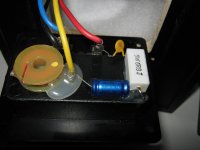
Dan.
Last edited:
Those are the regular diet for high-end audio dealers. Not likely to go away anytime soon.I do not understand these hobby stereotypes and superstitions.
Yes, how are flowers pollinated? ByBee.hahaha. Just having fun with you. Of the 3, you seem to be here more than the others. But its true those topologies are obsolete. IMHO, of course.
So what's new? Glad you asked. I escaped the new Trumps' USA and now living permanently in Thailand. Since I dont really like hand making (DIY) my own things, I now have a whole factory I can get things made and prototyped fast. Let the fun begin.
What's a ByBee? Does anyone know?
-Richard
It's a 0.025R tantalum resistor mounted inside a concentric ceramic tube with rare earth oxide kiln fused 25R conductive coating and connected in parallel, but of course you knew that alreadyWhat's a ByBee? Does anyone know?
With your new Thailand cost of living savings you can afford to get yourself a couple of the big ones and try for yourself.
IME they do work as advertised but I don't like the sound, YMMV.
Dan.
Here is what they tell.What's a ByBee? Does anyone know?
-Richard
In about 2014, Bybee Technologies discovered a completely unique and revolutionary purification technique. At the time we called it "Crystal Technology". Today, we do not identify this technology by name in our products as it is standard technology that is built into all of our products. This technique is based on the science of spintronics. Spintronics is a relatively new science discovery; and we believe that we have succeeded in mimicing spintronics in our technology. It is built into our Quantum Purifies, and has made them even more effective; and is now implemented in all of our products.
In short, our new technology is energized by surrounding energies and then creates an electric and magnetic field of force. In this electric and magnetic field, the polarity of all electrons and protons are altered, affecting their oscillation by making them more aligned with each other. This reaction creates an affect that makes the transfer or sharing of electrons between atoms more streamline and efficient; and air molecules less resistant. In the past, we have attempted to explain in more detail, the science behind this technology. Unfortunately, we find that more information tends to bring out the skeptics, so we now elect to remain informative, yet vague. We like to say "most people don't know how the cell phone works, but that doesn't stop them from using it." We feel our products are similar in that it is not critical to know how they work in order to enjoy them.
We believe this new technology has many more possibilities. We continue to learn more and more about this technology and it's potentials every day. We are constantly seeking and finding ways to increase it's effectiveness.
ROFL.
Thank you for the pointers Mark. I need several 8 - 25W buffers. Scott's 10W is directly usable and simple enough. For higher power I'll try NP's trick you mentioned or bootstrap easier to procure opamps before going the route of OPA445 or other jfet input hv types. Whatever does the trick.
Interesting detail: it shows a large 1 meg input resistor which led me to have a further look at the spec sheet of the 711 and this shows the strength of a Fet input stage: this rather large and no doubt German inspired resistance will only causes some 10uV of DC-offset. Which is very good to begin with. So I'd build it like in the recipe.
But otherwise I agree with Pavel on the virtues of the OPA134, much more agreable to work with than LM4562 for example, also in the end result.
- Status
- Not open for further replies.
- Home
- Member Areas
- The Lounge
- John Curl's Blowtorch preamplifier part III
